Scientist who discovered giant insterstellar comet ‘Oumuamua hits out at ‘wild speculation’ it is an alien spacecraft set to study us
- Two researchers at Harvard University say cigar-shaped rock zooming through our solar system may have been sent by aliens using a giant solar sail
- Mysterious object Oumuamua arrived in our solar system in October 2017
- Robert Weryk discovered strange object in 2017 at the University of Hawaii’s Institute for Astronomy – and says the Harvard paper is ‘wild speculation’
View
comments
The researcher who discovered a cigar-shaped interstellar rock zooming through our solar system has dismissed claims from Harvard University it could be an alien spacecraft.
The Harvard researchers noted in a pre-print of their article that it was an ‘exotic scenario,’ but that ‘Oumuamua may be a fully operational probe sent intentionally to Earth vicinity by an alien civilization.’
However, Robert Weryk, who discovered the strange interstellar object in 2017 at the University of Hawaii’s Institute for Astronomy, told CBC’s Afternoon Drive their theory is ‘a bit of wild speculation’.
Scroll down for video
This photo released by the European Southern Observatory on November 20, 2017 shows an artist’s impression of the first interstellar object known to enter our solar system: Oumuamua
WHAT IS A LIGHTSAIL?
Much like the wind pushing a sailboat through water, solar sails rely on sunlight to propel vehicles through space.
The sail captures constantly streaming solar particles, called photons, with giant sails built from a lightweight material.
Over time, the buildup of these particles provides enough thrust for a spacecraft to travel in space.
‘I think it’s a remnant from another solar system. It’s just something that happened to run into us, and we were very lucky to have been operating the telescope that night and looking in that direction,’ Weryk said.
Oumuamua, the first interstellar object known to enter our solar system, accelerated faster away from the Sun than expected, hence the notion that some kind of artificial sail that runs on sunlight – known as a light sail – may have helped push it through space.
‘Currently there is an unexplained phenomena, namely, the excess acceleration of Oumuamua, which we show may be explained by the force of radiation pressure from the sun,’ co-author and Harvard astrophysicist Shmuel Bialy said.
‘However this requires the body to have a very large surface and be very thin, which is not encountered in nature.’
Their suggestion of an alien force at work went viral.
‘Honestly, that’s a bit of wild speculation,’ Weryk said when asked about the paper by Harvard scientists Abraham Leob and Shmuel Bialy.
‘(The Harvard researchers) decided to focus on another aspect of that, that it’s an alien space craft and that it has a solar sail type material that’s causing the non-gravitational trajectory. But we actually believe that’s not true based on the data we obtained.’
-
Powered exoskeleton suit weighing just 17lbs could help…
Facebook is DOWN: Site unavailable for users around the…
Beware of fake Elon Musk! Hackers take over Twitter accounts…
‘They are issuing barefaced lies’: Vets accuse ministers of…
Share this article
The Harvard team hypothesize that Oumuamua ‘may be a fully operational probe sent intentionally to Earth’s vicinity by an alien civilization.’
Other astronomy experts aren’t buying it either.
‘Like most scientists, I would love there to be convincing evidence of alien life, but this isn’t it,’ said Alan Fitzsimmons, an astrophysicist at Queens University, Belfast.
‘It has already been shown that its observed characteristics are consistent with a comet-like body ejected from another star system,’ he told AFP.
‘And some of the arguments in this study are based on numbers with large uncertainties.’
The JPL team has not yet worked out how to power the craft – and many of their ideas rely on technology that doesn’t yet exist, such as this laser sail being developed by the Breakthrough project, which hopes to make to same trip to Alpha Centairi.
Katie Mack, a well-known astrophysicist at North Carolina State, also took issue with the alien hype.
‘The thing you have to understand is: scientists are perfectly happy to publish an outlandish idea if it has even the tiniest sliver of a chance of not being wrong,’ she wrote on Twitter.
‘But until every other possibility has been exhausted dozen times over, even the authors probably don’t believe it.’
Asked if he believed the hypothesis he put forward, Bialy told AFP:
‘I wouldn’t say I ‘believe’ it is sent by aliens, as I am a scientist, and not a believer, I rely on evidence to put forward possible physical explanation for observed phenomena.’
A photo released by the European Space Agency on June 27, 2018 shows an artist’s impression of Oumuamua
The other co-author, Avi Loeb, chairman of Harvard’s astronomy department, told NBC News humanity may never know more about the mysterious object, since it has traveled far away and isn’t heading back.
‘It is impossible to guess the purpose behind Oumuamua without more data,’ Loeb was quoted as saying.
Their paper was accepted for publication in the Astrophysical Journal Letters, and will appear on November 12.
Oumuamua, Hawaiian for ‘messenger’ or ‘scout,’ was first viewed by telescopes in October 2017.
The alien rock is about 1,300 feet long (400 meters) long, and only about 130 feet wide.
WHAT IS ‘OUMUAMUA AND WHAT DO WE KNOW ABOUT IT?
A cigar-shaped asteroid named ‘Oumuamua sailed past Earth at 97,200mph (156,428km/h) in October.
It was first spotted by a telescope in Hawaii on 19 October, and was observed 34 separate times in the following week.
It is named after the Hawaiian term for ‘scout’ or ‘messenger’ and passed the Earth at about 85 times the distance to the moon.
It was the first interstellar object seen in the solar system, and it baffled astronomers.
Initially, it was thought the object could be a comet.
However, it displays none of the classic behaviour expected of comets, such as a dusty, water-ice particle tail.
The asteroid is up to one-quarter mile (400 meters) long and highly-elongated – perhaps 10 times as long as it is wide.
That aspect ratio is greater than that of any asteroid or asteroid observed in our solar system to date.
But the asteroid’s slightly red hue — specifically pale pink — and varying brightness are remarkably similar to objects in our own solar system.
Around the size of the Gherkin skyscraper in London, some astronomers were convinced it was piloted by aliens due to the vast distance the object traveled without being destroyed – and the closeness of its journey past the Earth.
Alien hunters at SETI – the Search for Extra-terrestrial Intelligence based at Berkeley University, California said there was a possibility the rock was ‘an alien artefact’.
But scientists from Queen’s University Belfast took a good look at the object and said it appears to be an asteroid, or ‘planetesimal’ as originally thought.
Researchers believe the cigar-shaped asteroid had a ‘violent past’, after looking at the light bouncing off its surface.
They aren’t exactly sure when the violent collision took place, but they believe the lonely asteroid’s tumbling will continue for at least a billion years.
Source: Read Full Article






